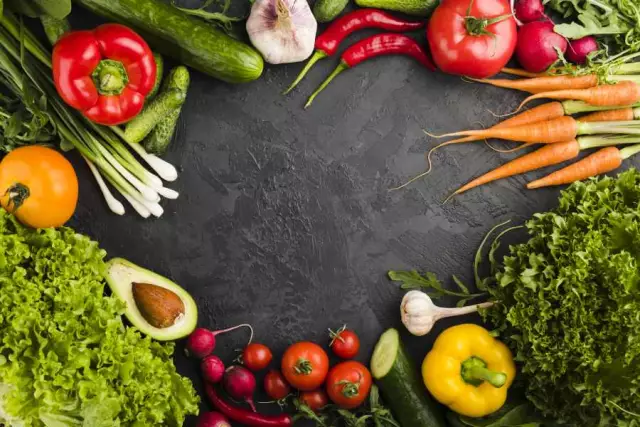- Author Rachel Wainwright [email protected].
- Public 2023-12-15 07:39.
- Last modified 2025-11-02 20:14.
8 foods to help improve circulation
Diseases of the cardiovascular system are among the leading causes of death in our country and around the world. The vast majority of such diseases develop against the background of sclerotic vascular changes. An important role in the appearance of pathologies of the vascular wall is played by the process of formation of the so-called cholesterol plaques. These are seals made of cholesterol molecules. They reduce the lumen of the vessel, reducing the speed of blood flow.

Source: depositphotos.com
Cholesterol (including its "bad" modifications) enters the human body with food of animal origin. In youth, when metabolic processes are intense, this substance is successfully removed from the bloodstream. Over time, metabolism slows down, and sometimes its disorders occur, associated with the gradual accumulation of the consequences of the harmful effects of aggressive factors, stress, unhealthy habits and various diseases. As a result, "bad" cholesterol is deposited on the walls of blood vessels, forming plaques. If untreated, the consequences can be very sad: a deterioration in blood flow is fraught with the development of pathologies such as varicose veins, angina pectoris, heart rhythm disturbances, acute heart failure, myocardial infarction and strokes.
The process of hardening of the walls of blood vessels can be stopped (and even reduced already existing violations) with the help of correctly selected therapy. In the initial stages of the disease, diet therapy is effective, consisting, in particular, in the inclusion in the diet of foods that can reduce the amount of bad cholesterol in the blood and improve the rheological properties of the blood.
Barley grits
Barley grains contain beta-glucan polysaccharide. In combination with a large amount of B vitamins and carotenoids, this substance actively reduces the level of bad cholesterol in the blood. The composition of barley includes components that reduce blood clotting and prevent the formation of blood clots.
To protect blood vessels, it is better to use not boiled barley grits (barley), but seedlings grown from whole (unpeeled) seeds.

Source: depositphotos.com
Flax seed
Flaxseed is a unique product rich in fiber and omega-3 fatty acids. Its use in food helps to remove excess cholesterol from the body and even reduce the size of existing sclerotic plaques. The best option for extracting nutrients is to prepare an aqueous infusion of flax seeds.
It should be noted that the beneficial properties of flaxseed are well preserved in cold-pressed flaxseed oil.

Source: depositphotos.com
Olive oil
Mediterranean cuisine is considered one of the healthiest in the world. Representatives of peoples adhering to the Mediterranean diet are less likely to suffer from sclerosis of the cerebral vessels. Experts believe that the reason for this phenomenon is the saturation of their diet with vegetables, fruits, seafood and olive oil.
Cold-pressed olive oil is rich in omega-9 fatty acids. They are easily absorbed by the body, help cleanse the blood of excess cholesterol, normalize metabolism, and increase the elasticity of the vascular walls.

Source: depositphotos.com
Nuts
Like other seeds, nuts are rich in biologically active substances that contribute to the overall health of the body and slow down the aging process. For maintaining the health of the cardiovascular system, walnuts and cashews are most useful: they increase the elasticity and tone of blood vessels, and help lower blood cholesterol levels. Almonds contain substances that activate the process of hematopoiesis.
It should be remembered that nuts are often the cause of allergic reactions, so their inclusion in the diet requires caution in people prone to allergies.

Source: depositphotos.com
Fatty fish
Fatty marine fish (herring, mackerel, halibut, etc.) are considered one of the best sources of Omega-3 polyunsaturated fatty acids. These products are recommended for elderly people as well as for patients with metabolic disorders. Fish is easier to digest than meat products, it contains complete animal proteins, vitamins and minerals (including iodine and phosphorus necessary for the body). Its regular use helps to actively fight the process of vascular hardening. It has been found that the inclusion of fatty sea fish in the daily diet reduces the risk of developing acute heart failure and myocardial infarction.

Source: depositphotos.com
Legumes
All legumes have a pronounced choleretic effect. Eating them regularly helps to rid the blood of excess cholesterol. Beans, peas, soybeans, lentils and beans are rich in proteins, which are similar in composition to animal proteins, although they are slightly less digestible.
For those who do not like or do not tolerate dishes made from ripe beans, green pods (shoulder blades) harvested at the stage of milk ripeness are perfect. The required amount of this tasty product can be grown independently in the garden and even on the balcony. Specially bred varieties of asparagus beans (cowpea), the pods of which reach 50-60 cm in length and remain soft for a long time.

Source: depositphotos.com
Avocado
This exotic fruit contains a large amount of unsaturated fats, which are easily digested and help lower blood cholesterol levels. Avocado also contains B vitamins, folic acid, copper compounds. It is one of the best antioxidant foods in the body. To maintain healthy heart and blood vessels, one avocado per week is enough.

Source: depositphotos.com
bitter chocolate
Bitter (containing a high percentage of cocoa butter) varieties of chocolate are not to everyone's liking, but they are rich in essential oils that have a beneficial effect on blood composition. A few bites of the treat will help remove excess cholesterol from your body and lower your platelet count.
Dark chocolate is effective in combating stress, increases overall body tone and performance, normalizes the immune system and improves memory.

Source: depositphotos.com
The danger of vascular hardening is associated, among other things, with the gradualness of the process. Cholesterol plaques form slowly, and pathology may not appear in any way for a long time. That is why it is necessary to periodically do tests to determine the concentration of "bad" cholesterol in the blood. It is recommended to start such examinations for men at the age of 30-35, and for women at the age of 40-45, and then repeat it every 5 years.
People who are at risk for cardiovascular pathologies should be especially attentive to their health. Factors that increase the likelihood of such diseases include:
- genetic predisposition;
- smoking;
- eating disorders;
- the presence of chronic diseases (hypertension, diabetes, etc.);
- obesity tendency;
- frequent stress;
- sedentary lifestyle;
- postmenopausal period in women.
The presence of pathological changes in blood vessels may be indicated by increasing headaches, dizziness, constant pain in the legs, fatigue, memory impairment, emotional instability, the appearance of visual illusions ("flies", color spots), hearing loss or vision loss. If you notice such symptoms, you should consult a doctor.
YouTube video related to the article:

Maria Kulkes Medical journalist About the author
Education: First Moscow State Medical University named after I. M. Sechenov, specialty "General Medicine".
Found a mistake in the text? Select it and press Ctrl + Enter.






